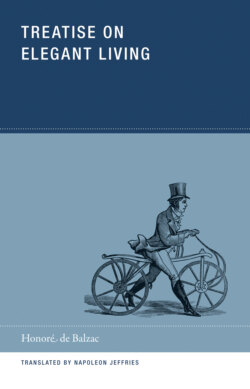Treatise on Elegant Living

Реклама. ООО «ЛитРес», ИНН: 7719571260.
Оглавление
Honoré de Balzac. Treatise on Elegant Living
TREATISE ON. ELEGANT LIVING
TREATISE ON. ELEGANT LIVING
CONTENTS
TRANSLATOR’S INTRODUCTION
NOTES
FIRST PART: GENERALITIES
FIRST CHAPTER: PROLEGOMENA
§ I—ON THE BUSY LIFE
APHORISMS
§ II—ON THE ARTIST’S LIFE
VI
§ III—ON THE ELEGANT LIFE
CHAPTER II: ON THE FEELING FOR ELEGANT LIVING
IX
CHAPTER III: OUTLINE OF THIS TREATISE
X
XI
SECOND PART: GENERAL PRINCIPLES
CHAPTER IV: DOGMAS
THIRD PART: ON THINGS THAT COME DIRECTLY FROM THE PERSON
CHAPTER v: ON CLOTHING IN ALL ITS PARTS
§ I—ECUMENICAL PRINCIPLES OF CLOTHING
NOTES
WAKEFIELD HANDBOOKS
Отрывок из книги
Honoré de Balzac, after the daguerreotype by Louis-Auguste Bisson, 1842.
Translated by Napoleon Jeffries
.....
Balzac did not, obviously, quite match up to the exacting standards he established in his treatise, and in the end, he himself probably did not see himself in the category. But he introduced a new category into the system, one placed squarely between the busy life and the elegant life: the thinking life of the artist. In Balzac’s words: “The artist is an exception: his idleness is work, and his work, repose; he is elegant and slovenly in turn; he dons, as he pleases, the plowman’s overalls, and determines the tails worn by the man in fashion; he is not subject to laws: he imposes them.”
This introduction of the category of artist would have lasting repercussions on dandyism, particularly the later dandyism of Baudelaire, who had no interest whatsoever in aristocracy, and who essentially presented himself to, and performed for (and ultimately rejected), the artist community. The category of artist is also what shapes Balzac’s portrayal of Brummell. Like most of his contemporaries, and despite Brummell’s presence in France (where he spent his last years in exile to escape his creditors), Balzac’s actual knowledge and understanding of the real Beau Brummell was superficial at best. The abstract nature of the figure of Brummell in France is illustrated by the fact that his very name was consistently misspelled (Balzac employed the spelling of “Brummel” that was standard in France at the time, but this has been adjusted for this translation). Barbey d’Aurevilly would later undertake his biographical portrait of Brummell without even knowing whether or not his subject had ever married; his portrait of the dandy was composed of carefully selected biographical facts which he assembled to create the personalized dandy he envisioned, rather than the dandy that had lived. It must be noted, then, that even though it had been written when Brummell was still alive, the Brummell who appears in Balzac’s treatise is pure fiction and inaccurate in a number of details (a few of which have been pointed out in the notes). What Balzac has him say, however, does the dandy justice. After poking some fun at the inevitable ravages of time upon the dandy (imagining a certain degree of portliness and a wig, details that fall short of the very depressing poverty and madness that in fact awaited Brummell in his final years), Balzac proceeds to envision him as the theorist, aphorist, and author that he never was in life. It is this effort that distinguishes Balzac’s approach to his subject, and it is a difference in evidence from his opening epigraph by Virgil: Mens agitat molem (Mind moves matter). If the effective and often accurate metaphor employed by the English anti-dandiacals described the dandy as an empty suit of clothes, Balzac here pointedly puts the man back into the suit. It is this shift that leads him to make what may at first be a surprising assertion midway through his treatise that the dandy is a “heresy of elegant living.” This dandy he refutes, though, is the dandy of the Regency, the dandy that is to be supplanted by the dandy he is heralding. The snobbery of two-dimensional dandyism was past, the dandy of gender and sexual politics was yet to come; this redefined dandyism, rooted in a redefined Brummell, was the dandyism of ambiguous tyranny, cynical defiance, reactionary rebellion, and budding modernism.
.....